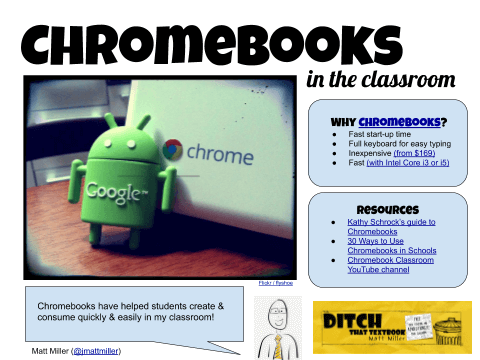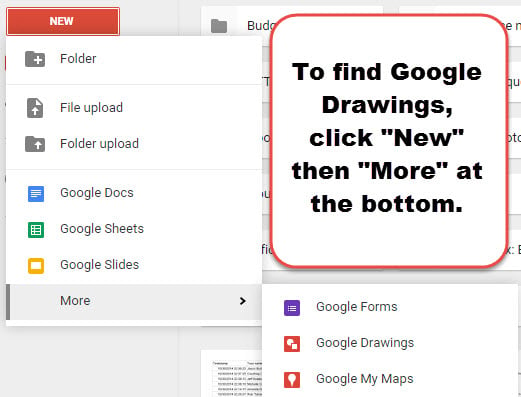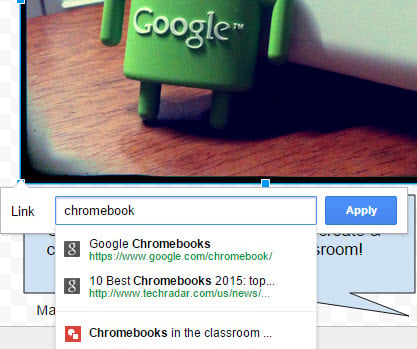
Forget the glue sticks, markers and magazines to cut for pictures. Create interactive posters with Google Drawings with links and Creative Commons photos. Here's how!
Students have created posters in so many classes for so many years. They’re visual, eye-catching and chock full of information.
They can be a hassle, though.
There’s all of the supplies: markers, glue sticks and the poster board itself (a bigger hassle if kids need to buy it and bring it in).
Then there are the magazines. In the past, I’ve had students cut pictures out of magazines to include in posters. Of course, that ends up being a mess. I usually find shards of magazine clippings all over my classroom for weeks afterward.
Thankfully, Google Apps has given us an outlet to have all the same perks of creating posters without as much of hassle. Google Drawings is a perfect medium for creating digital posters.
Plus, they don’t have to be the static posters of the past. These guys are INTERACTIVE.
Google Drawings is an app that gives you a blank slate (or blank poster board!) that you can add elements to. It’s not for linear text (like Google Documents). Plus, it’s not for multiple slides (like Google Slides) … just for one page.
 Find Google Drawings by clicking “New” in your Google Drive and then clicking on “More” at the bottom of that menu.
Find Google Drawings by clicking “New” in your Google Drive and then clicking on “More” at the bottom of that menu.
Now that you have a bright, shiny new Google Drawing in front of you, here are the parts of a poster you can add to it:
1. Title/headline: Use a text box at the top. Note that there are TONS of fun and eye-catching fonts you can use in Google. Just click on the font drop-down menu and select “More fonts” at the bottom.
2. Images: Don’t run to Google Images and do any old image search! Many of those images are copyright protected, and letting students do that isn’t encouraging them to be good digital citizens. Instead, within Google Drawings, go to “Insert > Image” or click the image button in the toolbar. Then select the “Search” tab at the top. This will search for Creative Commons-licenses images, which students can use and publish. (For more on that, see my post “How to get and use free images the RIGHT way in class“.)
3. Shapes: What fun is it to add a square or a circle to a Google Drawing? When you use it to organize content, of course! I like to put rectangles (my favorites are the ones with rounded edges) behind content to group it together visually. There are lots and lots of different useful shapes, including arrows for organization and flow charts AND starbursts to call attention to a word or phrase.
 4. Links: Here’s what makes these posters interactive! You can’t click old static posters on poster board. (Not sure that you’ve ever tried to, though …) Digital posters on Google Drawings are clickable. This allows students to extend the learning to webpages, videos and other content out on the Internet. It makes the project bigger than the project by itself!
4. Links: Here’s what makes these posters interactive! You can’t click old static posters on poster board. (Not sure that you’ve ever tried to, though …) Digital posters on Google Drawings are clickable. This allows students to extend the learning to webpages, videos and other content out on the Internet. It makes the project bigger than the project by itself!
Highlight some text or click on an image. Then use the link button in the toolbar or click “Insert > Link …”. (Pro tip: Use Ctrl+K / Command+K to avoid clicking. It’s one of my favorite keyboard shortcuts.) The beauty of adding links like this through Google Apps is that you can search for a site without leaving the page … the search bar is built right in! Brilliant!
(Note: For those viewing these digital posters to be able to click on links, they must go to the actual Google Drawing itself. You can’t save it as an image or embed it (as you’ll see next) and click on images.)
5. Embed: This lets you add a constantly-updating version of your image to a class website or e-portfolio. Go to “File > Publish to the web …”. Click the “Publish” button and “OK” to accept. Then click the “Embed” tab. You’ll see lots of HTML code there (don’t be scared!). Copy it. Then paste that HTML code in your class website in a spot where it says “Embed” or “HTML”. You’ll get a “live” version of the poster that updates on the site whenever you make changes. (Again, you’ll have to go directly to the Google Drawing file itself for the clickable links.)
Are you ready to get started with this in your classroom? It’s a quick win, very easy at virtually any grade level. Plus, it’s visual and fun!
How have you used Google Drawings in your classroom? What other features could be added to a Google Drawings interactive poster?
For notifications of new Ditch That Textbook content and helpful links:
Are you looking for quality, meaningful professional learning that both equips and inspires teachers?
Matt provides in-person and virtual keynotes, workshops and breakout sessions that equip, inspire and encourage teachers to create change in their classrooms. Teachers leave with loads of resources. They participate. They laugh. They see tech use and teaching in a new light. Click the link below to contact us and learn how you can bring Matt to your school or district!
Is Matt presenting near you soon? Check out his upcoming live events!



[…] Google Draw. The applications in education are numerous. In one Kindergarten class, the teacher created a […]
[…] of the least known tools within the Google Suite is Google Draw. The applications in education are numerous. In one Kindergarten class, the teacher created a […]
QR code to link to audio version of poster….student created radio ad or announcement.
[…] Google Drawings interactive posters – Matt Miller […]
[…] some more guidance? Check out my post on interactive Google Drawings posters with an example you can click on and copy into your Drive if you’d […]
[…] Google Drawings Interactive Posters – a nice guide with some great ideas on how you can use google drawings to create interactive posters. Adds some extra functionality and thinking to the traditional poster project. […]
I didn’t know that the search tool inside Google Drawings defaulted to a creative commons search. Turns out it defaults to cc images in all drive tools. Thanks — this was informative and helpful!
[…] Our friend J. Matt Miller over at Ditch That Textbook! has a great post on using Google Drawings for class poster projects: […]
Hi, Matt!
I’ve recently presented a training session on Google Drawings that included a link to one of your previous entries about Google Drawings (http://bit.ly/1Mo4CZf)! When I create and share my Google “Posters,” I download them as pdfs. The links are clickable on the pdf versions too. Something else my teachers and their students like knowing is that when you double-click on a shape, it automatically becomes a text box. Google Drawings is currently my favorite Google App!
Hey Matt and Melissa,
I too presented on Drawings at a recent GAFESummit (http://readwriterespond.com/?p=1144) and incorporated some old posts. I was actually challenged on how to make a Drawing file interactive. I was so stuck on the problem that you could not lock in objects. I tinkered with publishing, but overlooked embedding. This was the solution I was looking for. Although I really like Thinglink, it has a tendency of being blocked in some schools. Drawings offers something of a workaround to this problem.
I teach 7th Grade Technology and we just finished a project very similar to this idea. We called them Graphic Organizers. Students were paired up with a partner and they learned about ‘sharing’ a google drawing and collaborating on the project together. Each group was given a topic about Internet Safety, Cyber-bullying, Pros & Cons of Social Media, etc. They did research and worked together to create a poster sharing this important info. Then, we printed the posters in color and put them up in our shared Computer Lab at school so that all middle school students can see them and learn from them. I was truly amazed at how creative they were! It was awesome! Thanks for sharing your ideas. I love reading from your website!
[…] Google Drawings interactive posters (no glue sticks necessary!) | Ditch That Textbook @jmattmiller ditchthattextbook.com/2015/09/24/goo… […]
My students are working on quotation marks and dialogue. I had them use Google drawings to create a comic and then write the dialogue. They loved it!
[…] Sourced through Scoop.it from: ditchthattextbook.com […]